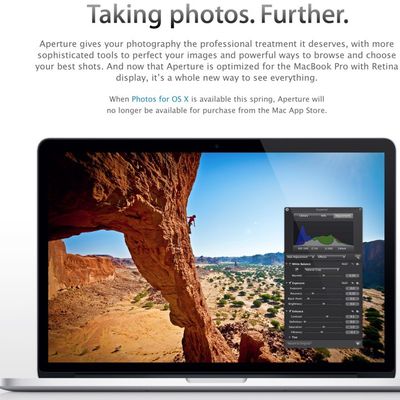Photoshop Or Aperture For Mac
- Adobe Photoshop For Mac
- Free Photoshop For Mac
- Photoshop Or Aperture For Macro
- Best Photoshop Software For Mac
- Photoshop Or Aperture For Mac High Sierra
When it comes to photo editing software that can enhance the images you capture with your digital camera, Apple Aperture and Photoshop are the top-of-the-line options that most professionals use. If you can’t manage to get the perfect shot in-camera, whether your lighting or exposure was off or there are objects in the background you need to remove, these creative programs will give you the ability to tweak the images until they are perfect.
Learning these intricate programs, however, takes time and dedication. Thankfully, there are many educational programs available online to teach you everything you need to know. For example, if you are a beginner, this course will teach you the basics of Photoshop, while this course is available for those who decide to work with Aperture instead.
Choosing the Program That is Right for You
Apple Aperture for Mac. $79.99 Apple Mac/OS X 10.10 Version 3.6 Full Specs. I have Aperture 3, Photoshop CS5, and Nikon Capture and use the Aperture 3 most often by a large margin. Last year John was kind enough to post an entry on his blog about how Aperture and Lightroom were faring in the pro community. The results as published by InfoTrends, an independent research firm, were conclusive in that Lightroom was the application of choice for pro photographers.(after Photoshop of course) InfoTrends has repeated the survey and the results are even more telling.
Both Apple Aperture and Adobe Photoshop have plenty to offer to those who work in photography in any capacity, whether you are a photo editor or the person behind the camera. But while these programs are highly regarded for all the features they have to offer, what you will probably find is that one of them is better suited to your needs. Below are the main features of each so you can decide which one is right for you and worth your time and investment.

Before diving into a photo editing program, check out this helpful blog post on taking great shots with your DSLR camera if you’re a beginner.
Apple Aperture: An Easy to Use Photo Management and Editing Program
Adobe Photoshop For Mac
One of the best things about Apple Aperture is its easy-to-use interface. Every tool that is found within the program has a label, so even beginners can get to know the program fairly quickly without having to guess at what they are clicking on. The interface is also customizable so you can choose how to sort your images and how to view them.
Apple Aperture comes with a variety of editing tools for enhancing photographs quickly and easily. Users can adjust the white balance, saturation, and overall color of an image, as well as convert any photo to black and white and correct unwanted lens vignettes. Stacking photos that are very similar makes it easy to keep track of them and make edits to all of them at once, saving time. This is one of the reasons why, if you are a beginner when it comes to editing images, Aperture is a great choice.
This program is also one of the best for managing images, as it makes it simple to rate each photo and label it accordingly. You can sort the photos into albums and label them with a particular color code and keywords that will make it easy to locate them in the future. On top of that, Aperture allows users to identify faces in the photos, tag the location of an image, and add copyright notices.
Aperture will automatically save all of your RAW files so you will always have access to the original photos, as well as the edited versions. Original camera settings are also found easily in each photo’s metadata.
Apple Aperture will only operate on a Mac platform. If you already prefer working on a Mac, a course in Aperture 3 will give you all the information you need to start using this program.
Photoshop: A Photo Editing Software That Goes Above and Beyond
Adobe Photoshop, which is available on both Mac and PC platforms, gives you all of the tools that professionals from a variety of creative fields use every day to make their work truly stand out. Beginners can experiment, but it is advisable to take a course in Photoshop for beginners if you are interested in using the more complex editing features within the program.
Photoshop CS6 and Photoshop CC are the latest versions of the software. CC provides everything that CS6 does, plus added features, including blur correction, camera shake reduction, and image upscaling. Photoshop is the program you want to have at your fingertips if you are serious about photography and you want to publish only the most crisp and vibrant photos.
Photoshop allows users to completely alter their images, whether they work with RAW files or JPEGs. By using layers, users can add special filters and effects to their images and remove them easily without affecting the rest of the photo. With the right filters, you can change an ordinary photograph into one that looks like an authentic painting or sketch, or you can enhance certain areas of the image while making other areas subtler. Colors can easily be enhanced or subdued as well, and images can be converted to black and white, sepia, and more.
Smoothing out edges and imperfections throughout a photograph is also easy with Photoshop, which allows you to do everything from clear blemishes from a model’s face to enhance the color of her eyes. And, of course, there is the option of altering the lighting and exposure if you did not get it right in-camera. The program goes far beyond simple editing features, though, and gives you plenty of custom shapes and brushes as well, which can all be used to turn your photographs into works of art, literally transforming what was in the original image.
In order to ensure you never lose your original files or your edited work, simply use the background save and auto recovery features already built into Photoshop.
Which Will You Choose?
When choosing between Apple Aperture and Adobe Photoshop, consider what you will primarily be using the program for and how much time you have to devote to it. If you are looking for a photo management system with easy editing capabilities, Aperture should suffice, but if you are a professional looking for more features, Photoshop is sure to give you everything you need. If you are still unsure, this course in Photoshop for photographers will help you see the potential in this program and help you determine whether or not you really need it or if you would prefer something simpler.
Free Photoshop For Mac


Photoshop Or Aperture For Macro
Here's how you can quickly migrate your photos from the Photos app or Aperture on macOS to Lightroom Classic.
Back up your catalog, if you have an existing Lightroom Classic catalog.
In Lightroom Classic on macOS, choose File > Plug-In Extras.
Select either Import from Aperture Library or Import from iPhoto Library.
Note:
If you want to migrate specific photos from your Aperture library to Lightroom Classic, export them to a new Aperture library and then migrate the new library.
Your libraries are automatically detected.
You have the option to select a different library, if applicable. Your images will be copied to a new location. A default location is listed, however you can also choose a different folder.
Click Options to see how Lightroom Classic works with available previews, keywords, color labels, and stacks.
METADATA

- Flags
- Star Ratings
- Keywords
- GPS Data
- Faces: Face naming tags are mapped to keywords
- Rejects: Files designated as Rejects in Aperture are imported into Collections > From Aperture > Photos Rejected in Aperture
- Info Panel metadata that can be entered in the Info panel (i.e. IPTC)
- Hidden Files: Files designated as Hidden in Photos are imported into Collections > From iPhoto > Photos Hidden in iPhoto
- Aperture Color Labels: Color Labels are mapped to keywords: Red, Orange, and so on, including support for custom label names
ORGANIZATION
- Aperture Stacking: Stacks information is mapped to keywords: Aperture Stack 1, Aperture Stack 2, and so on
- Aperture project/folder/album hierarchies are mapped as closely as possible into Lightroom Classic collection sets and collections
- Photos events/folders/albums are mapped as closely as possible into Lightroom Classic collection sets and collections
- Aperture Versions translate into Virtual Copies in Lightroom Classic (without adjustments)
EDITS
- You can choose to importfull-size JPEG previews of your edited images from Aperture/Photos, if they are up-to-date. This option is off by default. Lightroom Classic can automatically stack the preview with the original photo.
- Full-size JPEG previews generated from files with settings don't include metadata that has been applied to the master (keywords, star ratings, flags, GPS data).
- Full-size JPEG previews are duplicated if imported first by the same Photos library and then later from a library upgraded from Photos to Aperture (due to a difference in filename).
Note:
The plug-in supports migrating both managed and referenced Aperture and Photos libraries.
Best Photoshop Software For Mac
- If your files are managed by Aperture (Aperture's default) Lightroom Classic leaves them where they are and duplicates them in your chosen location.
- If your files are referenced by Aperture Lightroom Classic gives you the option of leaving them in their current location, or duplicating them in a new location.
What does not get migrated to Lightroom Classic?
Photoshop Or Aperture For Mac High Sierra
Some Photos/Aperture features are not compatible with Lightroom Classic. This includes:
- Image adjustments: Aperture and Lightroom use different image processing engines, so Lightroom cannot read adjustments made in Aperture. You can do one of the following:
- Re-edit your file using Lightroom Classic.
- Use Aperture to export full resolution edited photos and store them with the originals.
- Smart Albums
- Face Tag Region of Interest: Face naming tags are mapped to keywords
- Color Labels: Optionally as keywords
- Stacks: Optionally as keywords. Aperture shares stacks between albums, Lightroom does not
- Any kind of creation (books, web galleries, and so on) other than the collections that correspond to them
- PSD files can be imported into Lightroom only if they’re saved with ‘maximize compatibility’ enabled.
More like this
